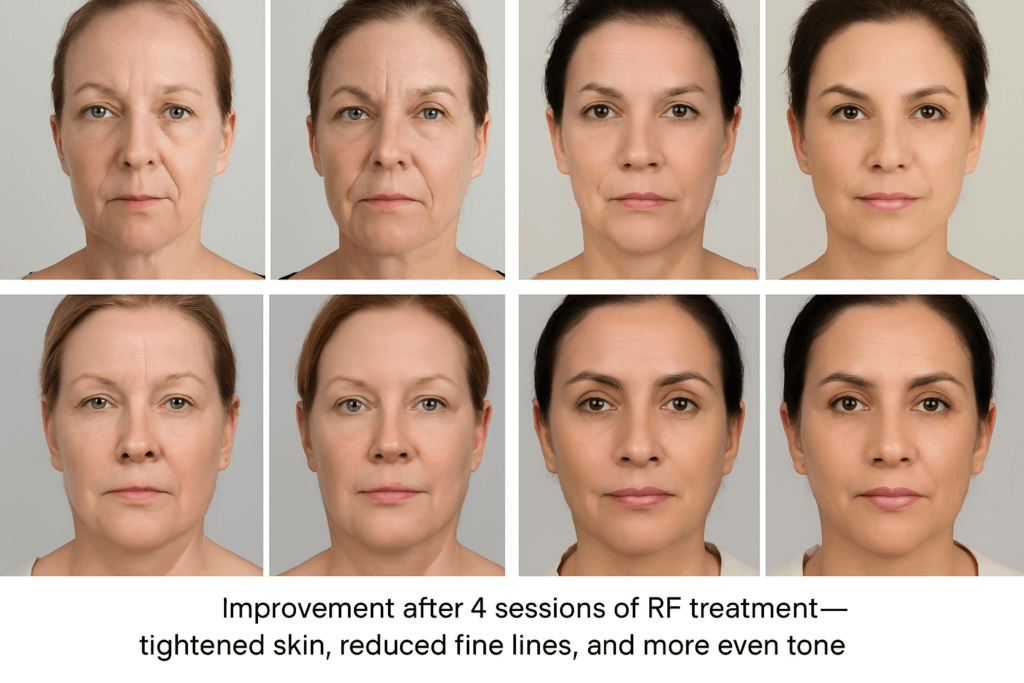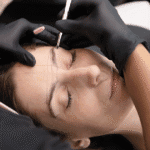1. When Fine Lines Interrupt Your Reflection
1.1 Laugh Lines, Worry Wrinkles
Fine lines, commonly referred to as rhytides, are early indicators of intrinsic aging and photoaging. Intrinsic aging is a natural process characterized by a decrease in fibroblast activity, leading to reduced collagen and elastin synthesis. Photoaging results from chronic ultraviolet (UV) exposure, which accelerates the degradation of dermal proteins. These processes manifest as periorbital lines (“crow’s feet”) and nasolabial folds, often termed laugh lines and worry wrinkles.
1.2 Smoother Skin, Smarter Tools
Advancements in dermatological technology have led to the development of non-invasive modalities aimed at mitigating fine lines. Radiofrequency (RF) devices, for instance, utilize electromagnetic energy to induce dermal remodeling. These tools offer a safer alternative to surgical interventions, with clinical studies demonstrating significant improvement in skin laxity and wrinkle reduction post-treatment.
2. The Science of Skin, Without the Scalpel
2.1 RF: Not Just for Radios
Radiofrequency energy, traditionally associated with communication technologies, has been repurposed in aesthetic medicine. In dermatology, RF operates within the 0.3 to 10 MHz range, delivering controlled thermal energy to the dermis. This targeted heating initiates a wound healing response, promoting neocollagenesis and elastogenesis without epidermal disruption.
2.2 Heat Sparks: How Skin Starts to Shift
The application of RF energy elevates dermal temperatures to approximately 67°C, the optimal range for collagen denaturation and subsequent remodeling . This thermal stimulus induces fibroblast proliferation and extracellular matrix reorganization, resulting in improved skin elasticity and texture.
2.3 Thermal Workouts for Collagen Comebacks
RF treatments can be likened to a “thermal workout” for the skin. The controlled heat exposure causes immediate collagen contraction, leading to skin tightening. Concurrently, the healing response stimulates long-term collagen synthesis, enhancing dermal thickness and reducing the appearance of fine lines.
2.4 Facelift Who? RF’s Drama-Free Rival
Compared to rhytidectomy (surgical facelift), RF treatments offer a non-invasive alternative with reduced risk and downtime. While surgical facelifts provide more dramatic results, RF procedures yield gradual, natural-looking improvements in skin laxity and wrinkle reduction. Patients often resume daily activities immediately post-treatment, highlighting the convenience of RF therapies.
3. Your Face on Frequency
3.1 Where Fine Lines Vanish First
Radiofrequency (RF) treatments are particularly effective in areas where the skin is thinner and more delicate, such as around the eyes (periorbital region), forehead, and nasolabial folds. These regions often show early signs of aging due to repetitive facial movements and reduced collagen density. RF energy penetrates the dermal layers, stimulating fibroblasts to produce new collagen and elastin fibers, leading to a reduction in fine lines and improved skin elasticity. Clinical studies have demonstrated significant improvements in these targeted areas following RF treatments.
3.2 Warm Pulse, Chill Vibes
The RF procedure involves delivering controlled thermal energy to the skin’s deeper layers, typically heating tissues to temperatures between 39°C and 45°C. This heat induces collagen denaturation and stimulates neocollagenesis, resulting in skin tightening and rejuvenation. Patients often describe the sensation as a warm, soothing pulse, with minimal discomfort and no need for anesthesia. The non-invasive nature of RF treatments allows for immediate return to daily activities, making it a convenient option for skin rejuvenation.
3.3 Real Faces, Real Stories

Patient testimonials and clinical case studies provide valuable insights into the efficacy of RF treatments. For instance, a study involving individuals with varying skin types showed notable improvements in skin texture and elasticity after multiple RF sessions. Histological analyses confirmed increased collagen and elastin fibers, corroborating the clinical observations. These real-world experiences highlight the transformative potential of RF therapy in achieving youthful, radiant skin.
4. RF’s Hidden Skin Superpowers
4.1 Bonus: Pores, Pigment & Texture
Beyond wrinkle reduction, RF treatments offer additional skin benefits. The thermal energy stimulates collagen production, leading to tighter skin and reduced pore size. Additionally, RF therapy promotes even skin tone by enhancing cellular turnover, which can diminish hyperpigmentation and improve overall skin texture. These cumulative effects contribute to a smoother, more refined complexion.
4.2 Bringing Back the Bounce
Skin elasticity diminishes with age due to decreased collagen and elastin production. RF treatments counteract this by stimulating fibroblast activity, leading to the synthesis of new collagen and elastin fibers. This restoration of the skin’s structural proteins results in improved firmness and resilience, effectively bringing back the youthful “bounce” to the skin.
4.3 Not Just Faces: RF for Hands & Neck
While the face is a common focus, RF treatments are also effective for other areas prone to aging, such as the hands and neck. The skin in these regions is often thinner and more susceptible to environmental damage, leading to wrinkles and sagging. RF therapy can improve skin texture and reduce the appearance of veins and tendons on the hands, as well as address skin laxity and horizontal neck lines, promoting a more youthful appearance overall.
4.4 How to Make That Glow Last
To maintain the benefits of RF treatments, it’s essential to adopt a comprehensive skincare regimen. Periodic maintenance sessions, typically every 6 to 12 months, help sustain results. Incorporating products with ingredients like retinoids, antioxidants, and peptides can support ongoing collagen production. Additionally, daily use of broad-spectrum sunscreen prevents photoaging and preserves treatment outcomes. By combining RF therapy with diligent skincare practices, individuals can enjoy long-lasting, radiant skin.
5. Smart Skin Decisions Start Here
5.1 Pick the Right Pro
Selecting a qualified practitioner is essential for safe and effective radiofrequency (RF) treatment. A professional with a medical background in dermatology or aesthetic medicine understands how to adjust RF settings—such as frequency, power output, and treatment duration—based on your skin type, age, and specific concerns. Skilled providers will also conduct a clinical evaluation, taking into account factors like skin thickness, degree of photoaging, and any underlying conditions. Evidence-based practice includes using diagnostic tools to assess skin laxity and collagen density before and after treatment, ensuring visible improvements are both measurable and safe.

5.2 RF Red Flags: Signs You’re Not in Expert Hands
There are warning signs that suggest a provider lacks the expertise required for RF skin rejuvenation. If no medical consultation is offered beforehand, or if your skin type isn’t evaluated in detail, that’s a cause for concern. Clinics that skip informed consent or avoid discussing side effects such as erythema, edema, or thermal injury may prioritize sales over safety. Another red flag is the use of devices without regulatory clearance or proper documentation on treatment protocols. A reputable provider will be transparent about their methods, expected outcomes, and the necessity for multiple sessions to achieve gradual collagen remodeling.
5.3 Patch First, Glow Later
Although RF is generally safe for a broad range of skin tones, conducting a patch test is a smart move—especially for individuals with sensitive or melanin-rich skin. The test involves applying RF energy to a small, discreet area (often behind the ear or along the jawline) to observe for any adverse reactions such as delayed blistering, hyperpigmentation, or excessive redness. Patch testing allows practitioners to identify individual sensitivities, helping them calibrate the treatment for maximum efficacy with minimal risk. This extra step not only enhances safety but also boosts patient confidence in the procedure.
5.4 Who Should Avoid RF?
Despite its wide applicability, RF treatment is not suitable for everyone. Individuals with implanted electronic devices (like pacemakers or cochlear implants), active skin infections, or autoimmune skin disorders may face heightened risks. Pregnant and breastfeeding individuals are generally advised to postpone RF treatment due to insufficient clinical data. Those with a history of hypertrophic scarring, poor wound healing, or pigmentary disorders may also need tailored protocols—or be better served by alternative treatments. A detailed medical history review should always precede treatment, ensuring contraindications are addressed before any RF device touches the skin.
6. FAQs
Q1. How long does it take to see visible results after RF treatment?
Most people notice initial skin tightening within a week, with peak collagen remodeling appearing around 6–12 weeks post-treatment. This delay is due to the skin’s natural healing and collagen regeneration timeline.
Q2. Does RF work better on certain types of wrinkles or lines?
Yes. RF is particularly effective for dynamic fine lines and mild to moderate static wrinkles, especially around the eyes, mouth, and forehead. Deeper folds may require combination therapies.
Q3. How often should I get RF treatments to maintain results?
For most skin types, 3–6 initial sessions spaced 2–4 weeks apart, followed by maintenance every 3–6 months, helps sustain collagen production and skin firmness.
Q4. Can RF be safely combined with other anti-aging treatments?
Absolutely. RF pairs well with microneedling, hyaluronic acid fillers, and LED light therapy. However, spacing between treatments should be advised by your provider to avoid overstimulation.
Q5. Is RF safe for darker skin tones?
Yes, RF energy targets deeper dermal layers without affecting melanin. Unlike some laser treatments, it carries a low risk of hyperpigmentation, making it suitable for Fitzpatrick skin types IV–VI.
Q6. What does RF actually feel like during treatment?
Patients describe the sensation as a warm, deep massage. Devices often include temperature sensors or cooling features to keep skin comfortable during the procedure.
Q7. Can RF treatments reduce acne scars and large pores too?
Yes. RF stimulates dermal remodeling, which improves skin texture, pore visibility, and mild atrophic acne scars over multiple sessions.
Q8. Is there a risk of skin damage or burns with RF?
When performed by trained professionals using calibrated, FDA-cleared devices, the risk is very low. However, improper technique or overheating can lead to epidermal burns or fat atrophy, especially with unregulated devices.
7. References
Radiofrequency Improves Facial Fine Lines by Thermal Effect: Damage or Just Stimulation?
https://onlinelibrary.wiley.com/doi/10.1111/jocd.16600
Radiofrequency facial rejuvenation: Evidence-based effect
https://pmc.ncbi.nlm.nih.gov/articles/PMC6541915
Cutaneous remodeling and photorejuvenation using radiofrequency devices








